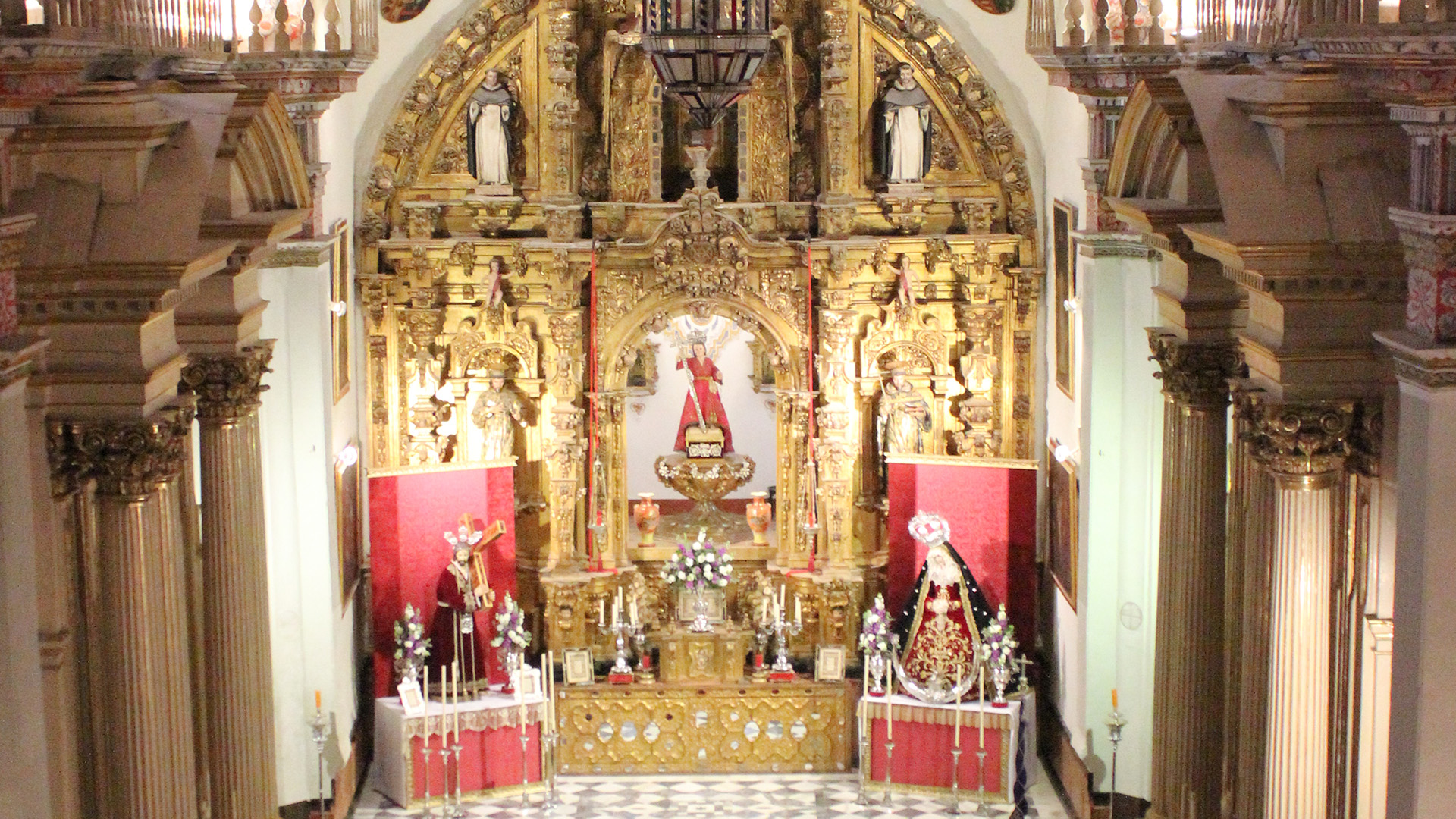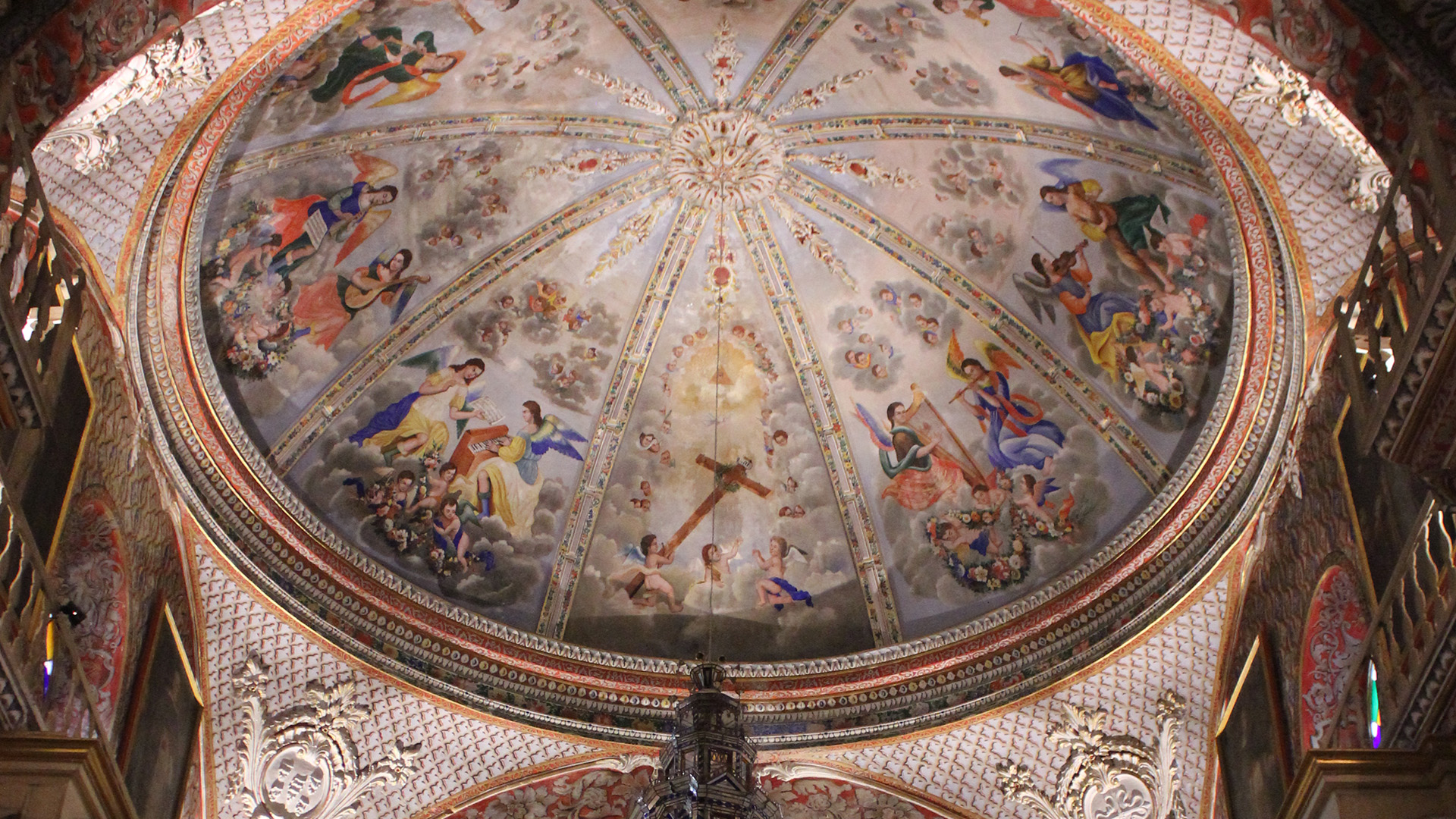Discover the Basilica of Santo Domingo.
The exterior is currently very simple. The Mannerist style cover has padded pilasters, as well as the arch voussoirage. The second body is formed by a beautifully garnished niche in which is placed the stone image of the Conception, owner of the temple. On both sides there are cartouches with shields of the Dominican order. The crowning of the façade was formed until the late nineteenth century by a false mixtilinear gable, centered by a shield of the order.
To give direct communication with the nave of the Epistle, the Brotherhood of the Rosary placed a small door of Granada marbles, dated in the last third of the eighteenth century. With the same function, the façade of the chapel of the Dulce Nombre de Jesús was carved, which is arranged at right angles to the main façade. Its construction can be dated around the year 1720.Currently this chapel is closed to the public because it is in a dilapidated state. The interior of the temple is the result of multiple transformations and additions of the nineteenth century.

The Mudejar armor that covers the central nave is a rather unique specimen, as it presents a showy polychromy in white, red, blue and gold. The main chapel, with a vault of half orange, is configured as a very defined spatial area, expanding towards the presbytery, which is covered with a quarter sphere. All this was decorated in tempera in the nineteenth century. The main altarpiece, from the eighteenth century, is a golden machine in which the stipe predominates as an element of support and decoration. The lateral interchanges are enriched with the images of San Francisco and Santo Domingo, attributed to the sculptor Andrés de Carvajal.
Also located in this main chapel are two huge altarpieces of neoclassical style, dated in the nineteenth century. On the Gospel side is the charming effigy of the Lost Child Jesus, slightly smaller than life. On the front of this altarpiece there is another identical one, presided over by the ancient image of Jesus of Nazareth, holder of the Pontifical and Royal Confraternity of Dulce Nombre de Jesús and Nuestra Señora de la Paz.
The sculpture of the Nazarene, carved in 1581, is the work of the artist Diego de Vega. From the main floron located in the key of the dome of this main chapel hangs a monumental lantern of tin and glass, once belonging to the famous “lamplight” of the Rosary. The nave of the Epistle, much lower than the central one, has four sections covered with groin vaults. In the first from the head is placed an altarpiece of the eighteenth century, whose central niche is occupied by the image of dressing Santo Domingo; on side shelves, good sculptures of Santa Rosa de Lima and Santo Tomás de Aquino. The next chapel offers no interest, except for the small dressing room where the dress image of the Virgin of Health is located.

In the next chapel is the image of Our Lady of the Rosary, of massive devotion in Antequera during the seventeenth to nineteenth centuries.The pillars of the access arch of the chapel to the central nave are covered with wood with profusion of carving blows, mirrors and interesting reliefs of San José and San Rafael made by Andrés de Carvajal. The rich artistic heritage of this image is partly preserved in the City Museum.
The altarpiece is reduced to a large golden frame, due to the dilated mouth of the dressing room. The door of the tabernacle, embossed and chiseled silver, probably the work of José Ruiz, represents the apotheosis of St. Thomas Aquinas, and is considered one of the most beautiful pieces of Antequera Baroque goldsmithing. The sumptuous dressing room, built before 1717, was quite renovated in the last third of the eighteenth century, when the agate plinth with Marian symbols in white stone was added. Note the presence of two frames with mirrors, donated in 1753.
The sculpture of the Virgin of the Rosary, made by Juan Vázquez de Vega in 1587, is placed on a golden wooden temple. As for the pictorial chapter, and regardless of the decoration of walls and vaults, made in the nineteenth century and much retouched later, we will especially point out the painting of “The Epidemic”, monumental votive offering dedicated to the Virgin of the Rosary, which shows the apocalyptic aspect of the city during the days of the plague epidemic of the year 1679.
Finally, among the processional belongings that make up the heritage of the brotherhood of the Dulce Nombre de Jesús, highlight the pallium of the Virgin of Peace, the processional base carved in 1682 by Antonio del Castillo and gilded by Manuel de Borja, the silver cross carried by the Nazarene, made in the last quarter of the seventeenth century and the processional base of the Dulce Nombre, Coated with gilded silver applications.
Contact:
Address: Cuesta de la Paz, 16, Antequera, Málaga
Schedule: Saturdays from 12:00 to 14:00
